Death of 35 Indians
A Secret Comes Out
This used to be a prisoner’s island in the 19th century. Today it is a conservatory area, but largely inaccessible. The Indian population of Guadeloupe led by Michel Narayninsamy, GOPIO Guadeloupe president, wanted a memorial erected here in memory of 35 Indians, including one woman, who were left to die in the prisons here. The Indians were punished because they wished to return back to India since the recruiting agents had gone back on their promise of finding them gold in Guadeloupe. There was no gold. Instead, they were asked to mow down sugarcane fields with sickles and scythes. In 2012, following GOPIO’s demand, a plaque dedicated to the memory of the 35 Indians was installed at the island of Les Saintes by the local mayor
|
|
|
|
|
|
AN ISLAND’S DARK SECRET
As our motor boat pulls away and Les Saintes fades behind us in the distance, the tiny island of Ilet A Cabrits begins to rise from the deep blue waters, much like a dark green rock emerging slowly out of the Caribbean Sea. The immensely forested rock, otherwise a speck in the vast blue waters of the West Indies, holds a secret from the 19th century.
Fifteen minutes by boat separate the two islands. Ilet A Cabrits (meaning Island of Goats) is covered with dense forests, and is uninhabited. It has been declared a naturally protected site by the Conservator of Coastal Areas and Lakes in Guadeloupe.
But once it was a prison, referred to in a lighter vein by locals as Guadeloupe’s
Alcatraz—the high security American prison just off the bay area in San Francisco. It is at the Ilet A Cabrits that the Indians who rebelled and wanted to return home were sent for punishment. And then left to rot and die. Euphemistically, the prison here was referred to as the House of Correction, as though correction was the real purpose of sending those who wanted nothing but freedom.
Between 1860 and 1874, thirty four convicted men and one woman were deported to Ilet A Cabrits on grounds of insubordination. The convicts were divided in two lots, observed one Captain
Bonnemaison. The ones who were sentenced to a year’s imprisonment were lodged in a separate penitentiary. The ones convicted of more serious offence were sent to another building with one large room, about 70 feet long and eight feet wide. All of them, including some African prisoners, were kept here, much like cattle would be herded into a barn. There were no beds, and no benches. They were sometimes made to do hard
labour. Otherwise, they awaited deportation to French Guiana, on the border with Brazil in mainland Latin America.
At Les Saintes is the memorial dedicated to these Indians who were convicted and left to wither away by power-drunk authorities who knew very little other than using the force of the whip and the sharp rap of the stick on human beings brought from afar.
Bonnemaison has recorded that “they showed us the disciplinary cells. They were tombs of stones, 2 metres long 1.50 metre wide, 2.6 metres high. The prisoner would sit on the bare floor with his shoulder and head against the wall, his feet shackled and dangling 0.25 metres above the floor.” It amounted to inhuman treatment of the indentured laborers at its deplorable low. |
L’ïlet Cabri et son terrible secret
Alors que nous nous éloignons des Saintes par bateau, nous entrevoyons au loin l’Ilet
Cabri, petit rocher vert émergeant de la mer des Caraïbes.
Cet îlet perdu dans les eaux bleues des Antilles cache un lourd secret datant du 19iem siècle.
Quinze minutes de bateau séparent les deux îles. L’Ilet Cabri est couvert d’une dense forêt et est inhabité. C’est actuellement un site naturel protégé par Conservatoire du littoral de Guadeloupe.
Mais, il y a bien longtemps, c’était une prison, appelée l’Alacatraz de Guadeloupe en référence à la prison de haute sécurité de San Francisco.
Les Indiens qui se rebellaient et exigeaient de rentrer chez eux étaient envoyés à l’Ilet
Cabri. Jusqu’à leur mort.
Ironiquement, la prison était appelée Maison de Correction, comme si on pouvait enfermer quelqu’un pour le corriger de vouloir sa liberté....
Entre 1860 et 1874, trente-quatre hommes et une femme furent déportés à l’Ilet Cabri pour insubordination.
Selon le Capitaine Bonnemaison, les prisonniers étaient séparés en deux : ceux qui étaient condamnés à un an de prison et ceux qui étaient condamnés pour de plus graves délits, qui
eux, étaient envoyés dans un bâtiment faisant 21 mètres de long et 2,5 mètres de large.
Tous, des prisonniers africains inclus, y étaient entassés là comme des
animaux.
Pas de lits, pas de chaises.
Parfois, on les faisait travailler, en attendant le départ pour Cayenne, en Guyane Française, au nord de l’Amérique
Latine.
Aux Saintes se trouve le mémorial dédié à ces Indiens qui furent condamnés et laissés mourir à petit feu par des autorités coloniales qui ne savaient qu’utiliser la force du fouet et le coup de baguette sur des êtres humains amenés de l’étranger.
Bonnemaison a rapporté : « ils nous ont montrés les cellules
disciplinaires, c’étaient des tombes en pierre, 2 mètres de long, 1.5 mètre de large, 2.6 mètres de hauteur.
Le prisonnier s’asseyait sur le sol nu avec ses épaules et sa tête contre le
mur, ses pieds enchaînés se balançant à 0.25 mètres du sol. » |
|
|
The remains of the 19th century prison where the Indians died. At left, some of the prisoners who were made to crush stones
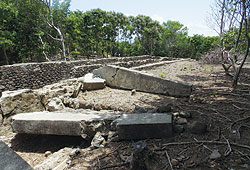
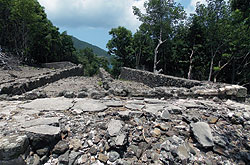
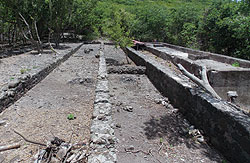
|
|
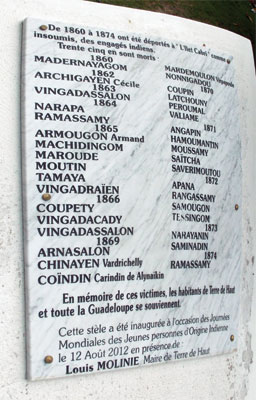 |
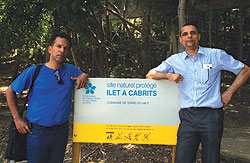
Journalists Jean Regis Ramsamy (left) from Reunion Island and Sayantan Chakravarty from India at Ilet A Cabrits |
|
The 19th century
island was a prison with a House for
Correction. It was here that 34 Indian men and
1 woman were sent for rebelling against the
authorities of the day. Tortured and
abandoned, they were left to die at this
island. Today it is a conserved territory
|
|
ROLE OF GOPIO GUADELOUPE
Led by Mr Michel Narayninsamy, the GOPIO Guadeloupe led a campaign to recognize a memorial to those 34 Indian men and single woman who valued their freedom above all else.
The GOPIO Guadeloupe believes that the Indian story in Guadeloupe needs to be told to the world. It is a result of the toil and hard work put in by the Indians brought in from the erstwhile French territories in
India—Pondicherry, Karaikal, Mahe, Yanam and
Chandernagore—that France’s plantation economy prospered. Yet, the manner in which these laboring men and women were treated by the colonialists leaves much to be desired. The memorial in Les Saintes and the remains of the prisons in Ilet A Cabraits are stark reminders that those who sailed away from Indian shores in search of a better life were often being pushed to the brink. Survival could not have been easy. And some were dying for merely asking for freedom to be released from their bondage. |
Rôle du GOPIO Guadeloupe
Mené par M. Michel Narayninsamy, le GOPIO Guadeloupe a fait campagne pour rendre hommage avec ce mémorial à ces 34 Indiens et cette Indienne qui voulaient leur liberté à tout prix.
Le GOPIO Guadeloupe pense que l’histoire des Indiens de Guadeloupe doit être connu de
tous.
L’économie sucrière prospéra grâce au travail sans relâche des Indiens venus des comptoirs Français : Pondichéry,
Karaikal, Mahé, Yanam et Chandernagore.
La façon dont ces hommes et femmes ont été traités par les autorités coloniales est plus que
discutable.
Le mémorial des Saintes et les ruines de la prison de l’Ilet Cabri rappellent tristement que ceux qui ont quittés les terres indiennes poursuivant le rêve d’une vie meilleure étaient parfois jetés à la mer. Et certains mourraient pour avoir demandé leur liberté et être délivré de leur servitude. |
|
|
|
|
June 2013
|
|


|
|
|
|